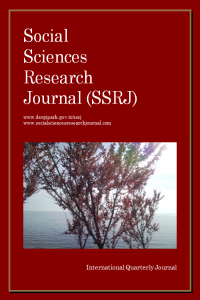Teacher Portfolios are on Stage for Professional Development: A Qualitative Case Study
Teacher Portfolios are on Stage for Professional Development: A Qualitative Case Study
The aim of this study was to explore the impact of teacher portfolios on promoting professional development of teachers with a focus on the contributions and difficulties of portfolio construction process. Eight English teachers from Namık Kemal University, School of Foreign Languages participated in this study. Participants constructed teacher portfolios using INTASC standards during 2010- 2011 school years. A qualitative case study research method was applied to analyze the data gathered from pre- and post- interviews and submitted teacher portfolios. The results showed that teacher portfolios were effective on professional development in terms of organization and planning, self-awareness, self-reflection and self-evaluation, continuous teacher professional development, student motivation, confidence and professional satisfaction. However, the participants emphasized that lack of time; guidance and evidence were the main hindrances in the portfolio construction process. Teacher portfolios allowed teachers to reflect upon their teaching practices and provided teachers an alternative pathway for professional development.
___
- Athanases, S. (1994). Teachers' reports of the effects of preparing portfolios of literacy instruction. The Elementary School Journal, 94(4), 421-439.
- Bartell C. A., Kaye, C., & Morin, J. A. (Winter, 1998b). Portfolio conversation: A mentored journey. Teacher Education Quarterly, 25(1), 129-139.
- Brooks, J. G., & Brooks, M. G. (1993). In search of understanding: The case for constructivist classrooms. Alexandria, VA: Association for the Supervision and Curriculum Development.
- Bullock, A. A., & Hawk, P. P. (2005). Developing a teaching portfolio: A guide for pre service and practicing teachers (2nd Education. Jersey: Pearson
- Creswell, J.W. (2007). Qualitative inquiry and research design: Choosing among five approaches (2nd Ed.). Thousand Oaks, CA: Sage.
- Curry, S. (2000). Portfolio-based teacher assessment, Leadership, 29(3), 34-38. for Educational
- Denison, T. J. (2008). The perceived value of teacher portfolios in the early years enhancement(EYE) program by primary and secondary school teachers in Utah’s schools. PHD Diss Utah University, Logan, Utah.
- Gelfer, J., Xu, Y. &Perkins, P. (2004). Developing portfolios to evaluate teacher performance education. Early Childhood Education Journal, 32(2), 127-132. childhood
- Haertel, E. (1991). New forms of teacher assessment. Review of Research in Education, 17, 3-30.
- Johnson, K. E. (1997). The author responds . . . . TESOL Quarterly, 31, 779–782.
- Kinnard, J. (2007). From crayons to cyberspace - creating a professional teaching Thompson Wadsworth. Belmont, CA:
- Lyons, N. (1998). With portfolio in hand: Validating professionalism. New York: Teachers College Press. new teacher
- McNelly, T. A. (2002). Evaluations that ensure Principal Leadership (Middle-level Ed.), 3(4), 55-61. portfolios.
- Merriam, S. B. (1998). Qualitative research and case study applications in education. (Revised Ed.). San Francisco, California: Jossey-Bass Publishers.
- Miles, M. B., & Huberman, A. M. (1994). Qualitative data analysis: An expanded sourcebook. Thouand Oaks, California: Sage Publications.
- Moore, Z. & Bond, N. (2002). The use of portfolios assessment: A case study of foreign language middle school teachers in Texas. Foreign Language Annals, 35(1), 85-92. service teacher Ormrod, J. E. (2000). Developing psychology: (Multimedia edition) (3rd Ed.). New Jersey: Prentice-Hall, Inc. learners
- Ozmon, H. A., & Craver, S. M. (1992). Philosophical foundations of education, (5th Ed.). Englewood Cliffs, New Jersey: Prentice Hall, Inc.
- Painter, B. (2001). Using teacher portfolios. Educational Leadership, 58(5), 31-34.
- Perez, K., Swain, C., & Hartsough, C. S. (1997). An analysis of practices used to Education Quarterly, 25, 41-52. teachers. Teacher
- Perkins, P. G. and Gelfer, J. I. (1993). Portfolio assessment of teachers. The Clearing House, 66(4), 235-237.
- Pulliam, J. D., & Patten, James J. V. (1999). History of education in America, (7th Ed.). Upper Saddle River, New Jersey: Merrill Prentice Hall. Richardson, V. (1997). teaching and teacher education: Theory and practice. In V. Richardson (Ed.), Constructivist Building a world of new understandings (pp. 3-14). London: Falmer Press.
- Roberts, J. (1998). Language teacher education. London: Arnold.
- Seldin, P. (1991). Successful use of teaching portfolios. Bolton, VT: Anker.
- Teitel, L., Ricci, M., & Coogan, J. (1998) "Experienced Teaching Compliance vs. a Culture of Professional Development" in N. Lyons (ed.) With Portfolios in Hand. (pp.143-155) New York: Teachers College Press. Construct Portfolios: Culture of
- Vadeboncoeur, J. (1997). Child development and the purpose of education: A historical context for constructivism in teacher education. In V. Richardson (Ed.), Constructive teacher education: Building new Washington, D.C.: Falmer Press. (pp.15-37).
- Van Wagenen, L. & Hibbard, K. M. (1998). Building teacher portfolios. Educational Leadership, 20(2), 26–29.
- Velez-Rendon, G. (2002). Second-language teacher education: A review of the literature. Foreign Language Annals, 35(4), 457-467.
- Van Wagenen, L. & Hibbard, K. M. (1998). Building teacher portfolios. Educational Leadership, 20(2), 26–29.
- Wolf, K. (1996). Developing an effective teaching Leadership, 53(6), 34-37. Educational
- Wolf, K. & Dietz, M. (1998). Teaching portfolios: purposes and possibilities. Teacher Education Quarterly, 25(1), 9-22.
- Zubizarreta, J. (1994). Teaching portfolios and the beginning teacher. Phi Delta Kappan, 76(4), 323-327.
- Yayın Aralığı: Yılda 4 Sayı
- Yayıncı: Denta Florya ADSM Limited Company
